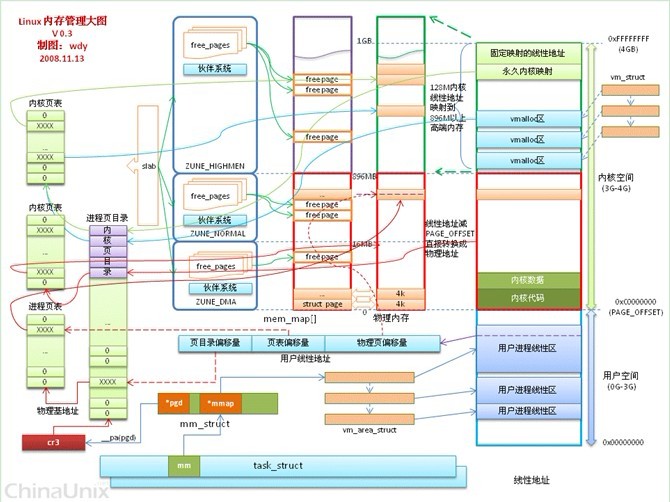内存管理-1
来源:互联网 发布:asp商城网站源码 编辑:程序博客网 时间:2024/05/16 14:21
linux 内存管理基于分段、分页把逻辑地址转换为物理地址,同时有些RAM永久的分配给了内核使用用来存放内核代码以及静态数据。其余的RAM为动态内存。linux中采用了很多有效的管理方法,包括页表管理、高端内存(临时映射区、固定映射区、永久映射区、非连续内存区)管理、为减小外部碎片的伙伴系统、为减小内部碎片的slab机制、伙伴系统未建立之前的页面分配制度以及紧急内存管理等等。。

此图copyfrom http://bbs.chinaunix.net/thread-2018659-2-1.html
页描述符:
页描述符记录页框的当前状态,类型为一个struct page的页描述符;所有的页描述符放在mem_map中,每个描述符场为32bytes,
/* * Each physical page in the system has a struct page associated with * it to keep track of whatever it is we are using the page for at the * moment. Note that we have no way to track which tasks are using * a page, though if it is a pagecache page, rmap structures can tell us * who is mapping it. * * The objects in struct page are organized in double word blocks in * order to allows us to use atomic double word operations on portions * of struct page. That is currently only used by slub but the arrangement * allows the use of atomic double word operations on the flags/mapping * and lru list pointers also. */struct page {/* First double word block */描述了页框的状态unsigned long flags;/* Atomic flags, some possibly * updated asynchronously */struct address_space *mapping;/* If low bit clear, points to * inode address_space, or NULL. * If page mapped as anonymous * memory, low bit is set, and * it points to anon_vma object: * see PAGE_MAPPING_ANON below. *//* Second double word */struct {union {pgoff_t index;/* Our offset within mapping. */void *freelist;/* slub/slob first free object */bool pfmemalloc;/* If set by the page allocator, * ALLOC_NO_WATERMARKS was set * and the low watermark was not * met implying that the system * is under some pressure. The * caller should try ensure * this page is only used to * free other pages. */};union {#if defined(CONFIG_HAVE_CMPXCHG_DOUBLE) && \defined(CONFIG_HAVE_ALIGNED_STRUCT_PAGE)/* Used for cmpxchg_double in slub */unsigned long counters;#else/* * Keep _count separate from slub cmpxchg_double data. * As the rest of the double word is protected by * slab_lock but _count is not. */unsigned counters;#endifstruct {union {/* * Count of ptes mapped in * mms, to show when page is * mapped & limit reverse map * searches. * * Used also for tail pages * refcounting instead of * _count. Tail pages cannot * be mapped and keeping the * tail page _count zero at * all times guarantees * get_page_unless_zero() will * never succeed on tail * pages. */atomic_t _mapcount;struct { /* SLUB */unsigned inuse:16;unsigned objects:15;unsigned frozen:1;};int units;/* SLOB */};atomic_t _count;/* Usage count, see below. */};};};/* Third double word block */union {struct list_head lru;/* Pageout list, eg. active_list * protected by zone->lru_lock ! */struct {/* slub per cpu partial pages */struct page *next;/* Next partial slab */#ifdef CONFIG_64BITint pages;/* Nr of partial slabs left */int pobjects;/* Approximate # of objects */#elseshort int pages;short int pobjects;#endif};struct list_head list;/* slobs list of pages */struct {/* slab fields */struct kmem_cache *slab_cache;struct slab *slab_page;};};/* Remainder is not double word aligned */union {unsigned long private;/* Mapping-private opaque data: * usually used for buffer_heads * if PagePrivate set; used for * swp_entry_t if PageSwapCache; * indicates order in the buddy * system if PG_buddy is set. */#if USE_SPLIT_PTLOCKSspinlock_t ptl;#endifstruct kmem_cache *slab;/* SLUB: Pointer to slab */struct page *first_page;/* Compound tail pages */};/* * On machines where all RAM is mapped into kernel address space, * we can simply calculate the virtual address. On machines with * highmem some memory is mapped into kernel virtual memory * dynamically, so we need a place to store that address. * Note that this field could be 16 bits on x86 ... ;) * * Architectures with slow multiplication can define * WANT_PAGE_VIRTUAL in asm/page.h */#if defined(WANT_PAGE_VIRTUAL)void *virtual;/* Kernel virtual address (NULL if not kmapped, ie. highmem) */#endif /* WANT_PAGE_VIRTUAL */#ifdef CONFIG_WANT_PAGE_DEBUG_FLAGSunsigned long debug_flags;/* Use atomic bitops on this */#endif#ifdef CONFIG_KMEMCHECK/* * kmemcheck wants to track the status of each byte in a page; this * is a pointer to such a status block. NULL if not tracked. */void *shadow;#endif}然而系统将物理内存划分为几个节点node,内存的每个节点都由pg_data_t描述,在分配一个页面时,linux采用节点局部分配的策略,从最靠近运行中的CPU的节点分配内存。由于进程往往是在同一个CPU上运行,因此从当前节点得到的内存很可能被用到。每个节点的物理内存又分为几个管理区zone,typedef struct pglist_data {struct zone <span style="white-space:pre"></span>node_zones[MAX_NR_ZONES]; 节点管理区描述数组struct zonelist node_zonelists[MAX_ZONELISTS];//页分配器使用的zonelist数据结构;该节点的备用内存区。当节点没有可用内存时,就从备用区中分配内存int nr_zones; 节点中管理区的个数#ifdef CONFIG_FLAT_NODE_MEM_MAP/* means !SPARSEMEM */struct page *node_mem_map<span style="white-space:pre"></span>节点中页描述符数组#ifdef CONFIG_MEMCGstruct page_cgroup *node_page_cgroup;#endif#endif#ifndef CONFIG_NO_BOOTMEMstruct bootmem_data *bdata;<span style="white-space:pre"></span>用在内核初始化阶段#endif#ifdef CONFIG_MEMORY_HOTPLUG/* * Must be held any time you expect node_start_pfn, node_present_pages * or node_spanned_pages stay constant. Holding this will also * guarantee that any pfn_valid() stays that way. * * Nests above zone->lock and zone->size_seqlock. */spinlock_t node_size_lock;#endifunsigned long node_start_pfn;<span style="white-space:pre"></span>节点中第一个页框的下标unsigned long node_present_pages; /* total number of physical pages */unsigned long node_spanned_pages; /* total size of physical page range, including holes */int node_id;<span style="white-space:pre"></span>节点标识符wait_queue_head_t kswapd_wait;<span style="white-space:pre"></span>kswapd页换出守护进程使用的等待队列wait_queue_head_t pfmemalloc_wait;struct task_struct *kswapd;指向kswapd的内核线程/* Protected by lock_memory_hotplug() */int kswapd_max_order; <span style="white-space:pre"></span>kswapd线程要创建空闲块取对数的值enum zone_type classzone_idx;} pg_data_t;所有的节点描述符存放在一个单向链表中,他的第一个元素由pgdat_list变量所指向每个内存节点的物理内存划分3个管理区 zone_DMA /zone_normal /zone_highmem
管理区描述符字段
struct zone {/* Fields commonly accessed by the page allocator *//* zone watermarks, access with *_wmark_pages(zone) macros *//*本管理区的三个水线值:高水线(比较充足)、低水线、MIN水线。*/ unsigned long watermark[NR_WMARK];/* * When free pages are below this point, additional steps are taken * when reading the number of free pages to avoid per-cpu counter * drift allowing watermarks to be breached */unsigned long percpu_drift_mark;/* * We don't know if the memory that we're going to allocate will be freeable * or/and it will be released eventually, so to avoid totally wasting several * GB of ram we must reserve some of the lower zone memory (otherwise we risk * to run OOM on the lower zones despite there's tons of freeable ram * on the higher zones). This array is recalculated at runtime if the * sysctl_lowmem_reserve_ratio sysctl changes. */<span style="white-space:pre"></span>/ * 当高端内存、normal内存区域中无法分配到内存时,需要从normal、DMA区域中分配内存。 * 为了避免DMA区域被消耗光,需要额外保留一些内存供驱动使用。 * 该字段就是指从上级内存区退到回内存区时,需要额外保留的内存数量。 */ unsigned longlowmem_reserve[MAX_NR_ZONES];/* * This is a per-zone reserve of pages that should not be * considered dirtyable memory. */unsigned longdirty_balance_reserve;#ifdef CONFIG_NUMAint node; /*所属的NUMA节点。*/ /* * zone reclaim becomes active if more unmapped pages exist. *//*当可回收的页超过此值时,将进行页面回收。*/ unsigned longmin_unmapped_pages; /*当管理区中,用于slab的可回收页大于此值时,将回收slab中的缓存页。*/ unsigned longmin_slab_pages;#endif<span style="white-space:pre"></span>/*每cpu高速缓存所用到,<span style="white-space:pre"> </span> <span style="white-space:pre"></span> <span style="white-space:pre">* 每CPU的页面缓存。 * 当分配单个页面时,首先从该缓存中分配页面。这样可以: *避免使用全局的锁 * 避免同一个页面反复被不同的CPU分配,引起缓存行的失效。 * 避免将管理区中的大块分割成碎片。 */ </span>struct per_cpu_pageset __percpu *pageset;/* * free areas of different sizes */spinlock_tlock;int all_unreclaimable; /* All pages pinned */#if defined CONFIG_COMPACTION || defined CONFIG_CMA/* pfn where the last incremental compaction isolated free pages */unsigned longcompact_cached_free_pfn;#endif#ifdef CONFIG_MEMORY_HOTPLUG/* see spanned/present_pages for more description */<span style="white-space:pre"> /*该锁用于保护伙伴系统数据结构。即保护free_area相关数据。*</span>/seqlock_tspan_seqlock;#endif#ifdef CONFIG_CMA/* * CMA needs to increase watermark levels during the allocation * process to make sure that the system is not starved. */unsigned longmin_cma_pages;#endif<span style="white-space:pre">/*伙伴系统的主要变量。这个数组定义了11个队列,每个队列中的元素都是大小为2^n的页面*/ </span>struct free_areafree_area[MAX_ORDER];#ifndef CONFIG_SPARSEMEM/* * Flags for a pageblock_nr_pages block. See pageblock-flags.h. * In SPARSEMEM, this map is stored in struct mem_section */ /*本管理区里的页面标志数组*/ unsigned long*pageblock_flags;#endif /* CONFIG_SPARSEMEM */#ifdef CONFIG_COMPACTION/* * On compaction failure, 1<<compact_defer_shift compactions * are skipped before trying again. The number attempted since * last failure is tracked with compact_considered. */unsigned intcompact_considered;unsigned intcompact_defer_shift;intcompact_order_failed;#endif<span style="white-space:pre">/*填充的未用字段,确保后面的字段是缓存行对齐的*/ </span>ZONE_PADDING(_pad1_)<span style="white-space:pre"></span>/* <span style="white-space:pre"></span> * lru用于确定哪些字段是活跃的,哪些不是活跃的,<span style="white-space:pre"></span> *并据此确定应当被写回到磁盘以释放内存。 <span style="white-space:pre"></span>*//* Fields commonly accessed by the page reclaim scanner */spinlock_tlru_lock;struct lruveclruvec;unsigned longpages_scanned; /* since last reclaim */unsigned longflags; /* zone flags, see below *//* Zone statistics */atomic_long_tvm_stat[NR_VM_ZONE_STAT_ITEMS];/* * The target ratio of ACTIVE_ANON to INACTIVE_ANON pages on * this zone's LRU. Maintained by the pageout code. */unsigned int inactive_ratio;ZONE_PADDING(_pad2_)/* Rarely used or read-mostly fields *//* * wait_table-- the array holding the hash table * wait_table_hash_nr_entries-- the size of the hash table array * wait_table_bits-- wait_table_size == (1 << wait_table_bits) * * The purpose of all these is to keep track of the people * waiting for a page to become available and make them * runnable again when possible. The trouble is that this * consumes a lot of space, especially when so few things * wait on pages at a given time. So instead of using * per-page waitqueues, we use a waitqueue hash table. * * The bucket discipline is to sleep on the same queue when * colliding and wake all in that wait queue when removing. * When something wakes, it must check to be sure its page is * truly available, a la thundering herd. The cost of a * collision is great, but given the expected load of the * table, they should be so rare as to be outweighed by the * benefits from the saved space. * * __wait_on_page_locked() and unlock_page() in mm/filemap.c, are the * primary users of these fields, and in mm/page_alloc.c * free_area_init_core() performs the initialization of them. */wait_queue_head_t* wait_table;unsigned longwait_table_hash_nr_entries;unsigned longwait_table_bits;/* * Discontig memory support fields. */ /*管理区属于的节点*/ struct pglist_data*zone_pgdat;/* zone_start_pfn == zone_start_paddr >> PAGE_SHIFT */unsigned longzone_start_pfn; /*管理区的页面在mem_map中的偏移*/ /* * zone_start_pfn, spanned_pages and present_pages are all * protected by span_seqlock. It is a seqlock because it has * to be read outside of zone->lock, and it is done in the main * allocator path. But, it is written quite infrequently. * * The lock is declared along with zone->lock because it is * frequently read in proximity to zone->lock. It's good to * give them a chance of being in the same cacheline. */unsigned longspanned_pages;/* total size, including holes */unsigned longpresent_pages;/* amount of memory (excluding holes) *//* * rarely used fields: */const char*name;#ifdef CONFIG_MEMORY_ISOLATION/* * the number of MIGRATE_ISOLATE *pageblock*. * We need this for free page counting. Look at zone_watermark_ok_safe. * It's protected by zone->lock */intnr_pageblock_isolate;#endif} 0 0
- Linux内存管理(1)
- 内存管理[1]
- 内存管理1
- 内存管理(1)
- 内存管理1
- iphone 内存管理1
- JAVA内存管理1
- Windows内存管理(1)
- 内存管理篇1
- 内存管理(1)
- 内存管理(1)
- 内存管理小结1
- 操作系统-------内存管理(1)
- java内存管理1
- 八---内存管理1
- 内存管理(1)
- apache内存管理1
- OC内存管理-1
- 记录
- codeforces 670A Holidays
- 深入JVM——栈和局部变量
- 第十、十一周项目一-点-圆-圆柱类族的设计(2)
- C++实验5
- 内存管理-1
- Android动画设置
- cocos2d-x 翻转卡牌 效果 动画 flip card effect
- Android中Service(服务)详解
- jsp中的$/%说明
- wireshark工具及过滤语法
- ios中利用NSDateComponents、NSDate、NSCalendar判断当前时间是否在一天的某个时间段内。
- 浅谈UML的概念和模型之UML九种图
- Spark Streaming入门详解


